
Pros and Cons of Pea Gravel for Playgrounds
King Swings offers wood mulch, rubber mulch, and poured-in-place rubber flooring for playgrounds. But what if you are a DIY type of person who really wants to explore some alternate options for surfacing?
That is great! I will dedicate a few blog posts about different types of playground or swing set area surfacing that we don’t offer. Let’s start with pea gravel.
As always, with products King Swings doesn’t offer, make sure you do your own research and be confident in your decision. Talk to the provider of the material.
What is Pea Gravel and How is it Used in Playgrounds?
Pea gravel is a small, rounded rock that is about the size of a pea. It is often used in landscaping and as a base material for driveways and paths, and it can also be used as a playground surface. Pea gravel provides a natural, aesthetically pleasing look to a playground.

Pros of Pea Gravel as a Playground Surface
- Affordability: Pea gravel is a relatively inexpensive option for playground surfaces, making it a popular choice for those on a budget. To be clear, the material is not expensive though it is labor intensive.
- Natural Appearance: Pea gravel has a natural, earthy appearance that blends well with outdoor environments, making it a visually appealing option for playgrounds.
- Versatile: Pea gravel can be used for various playground activities, including creating soft landing areas underneath play equipment. Pea gravel can also be fun if you provide digging toys and trucks!
- Good Drainage: Pea gravel provides excellent drainage, so it’s a great option for areas that receive a lot of rain or have poor drainage. This means that your playground will be less likely to get bogged down or flooded, making it a safer place to play.
Cons of Pea Gravel as a Playground Surface
- Messy: Pea gravel can be messy, especially if children start playing with it and throwing it around. This means that you’ll need to regularly clean up the area to keep it looking neat and tidy. This is not great for low-cutting lawnmowers.
- Cost of Installation: Installing pea gravel as a playground surface can be labor-intensive, making it more expensive than other options, such as rubber mulch or sand, if you get a professional to do your installation. However, if you are putting in sweat and tears, then you can save a lot.
- Quantity: Pea gravel does require a significant depth to meet ATSM requirements for commercial playgrounds. As a residential setting, it is up to you if you want to go as deep but do your research.
- Accessibility: Pea gravel does not allow wheelchair access to the set, nor is it very friendly to those with disabilities. This is a big reason you don’t see pea gravel used in commercial playgrounds very often.
Safety Considerations
- Depth: The depth of the pea gravel should be at least 9 – 18 inches to provide proper cushioning in case of a fall. This varies depending on the fall height of your swing set.
- Regular Maintenance: It is essential to regularly inspect the pea gravel surface and rake it to prevent tripping hazards or compacted areas.
- Edging: Edging should be in place to keep the pea gravel contained within the playground area and prevent the spread of gravel beyond the playground boundaries.
- Proper Installation: It is important to make sure you got enough material, install it evenly, and take into consideration your fall height.
- Wintering: Freezing rains and snow can create a hard, frozen top layer of your pea gravel.
- Quality of Pea Gravel: The quality of the pea gravel used for the playground should be safe for children and free from harmful contaminants.
Final Thoughts
Pea gravel can be an excellent option for a playground surface, but it’s essential to consider the pros, cons, and safety considerations before making a decision. Whether planning a new playground or replacing an existing surface, pea gravel can provide an affordable, visually appealing, and versatile option.
This guide is meant to be informative and for residential applications only. When installing in a residential setting, you are responsible for the research, depth, material, and maintenance of your playground.

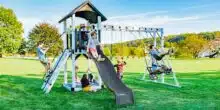 Small Series
Small Series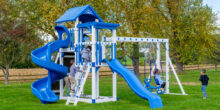 Medium Series
Medium Series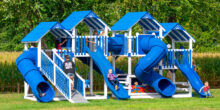 Large Series
Large Series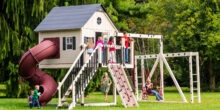 Playhouse Series
Playhouse Series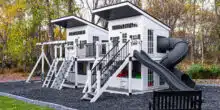 Custom Swing Sets
Custom Swing Sets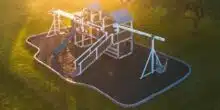 How It Works
How It Works Bargain Corner
Bargain Corner Swing Set Color Options
Swing Set Color Options